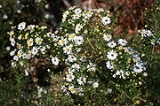
Symphyotrichum ericoides
Encyclopedia
Symphyotrichum ericoides, commonly known as the White Aster or Heath Aster, is an herbaceous perennial in the composite family
. It is native to much of North America
including the northwestern, central and eastern United States
, much of Canada
, as well as northern Mexico
, and has also been introduced to many areas beyond its native range.
Asteraceae
The Asteraceae or Compositae , is an exceedingly large and widespread family of vascular plants. The group has more than 22,750 currently accepted species, spread across 1620 genera and 12 subfamilies...
. It is native to much of North America
North America
North America is a continent wholly within the Northern Hemisphere and almost wholly within the Western Hemisphere. It is also considered a northern subcontinent of the Americas...
including the northwestern, central and eastern United States
United States
The United States of America is a federal constitutional republic comprising fifty states and a federal district...
, much of Canada
Canada
Canada is a North American country consisting of ten provinces and three territories. Located in the northern part of the continent, it extends from the Atlantic Ocean in the east to the Pacific Ocean in the west, and northward into the Arctic Ocean...
, as well as northern Mexico
Mexico
The United Mexican States , commonly known as Mexico , is a federal constitutional republic in North America. It is bordered on the north by the United States; on the south and west by the Pacific Ocean; on the southeast by Guatemala, Belize, and the Caribbean Sea; and on the east by the Gulf of...
, and has also been introduced to many areas beyond its native range.

